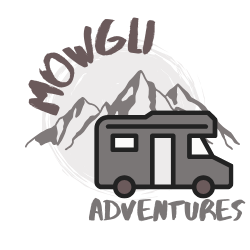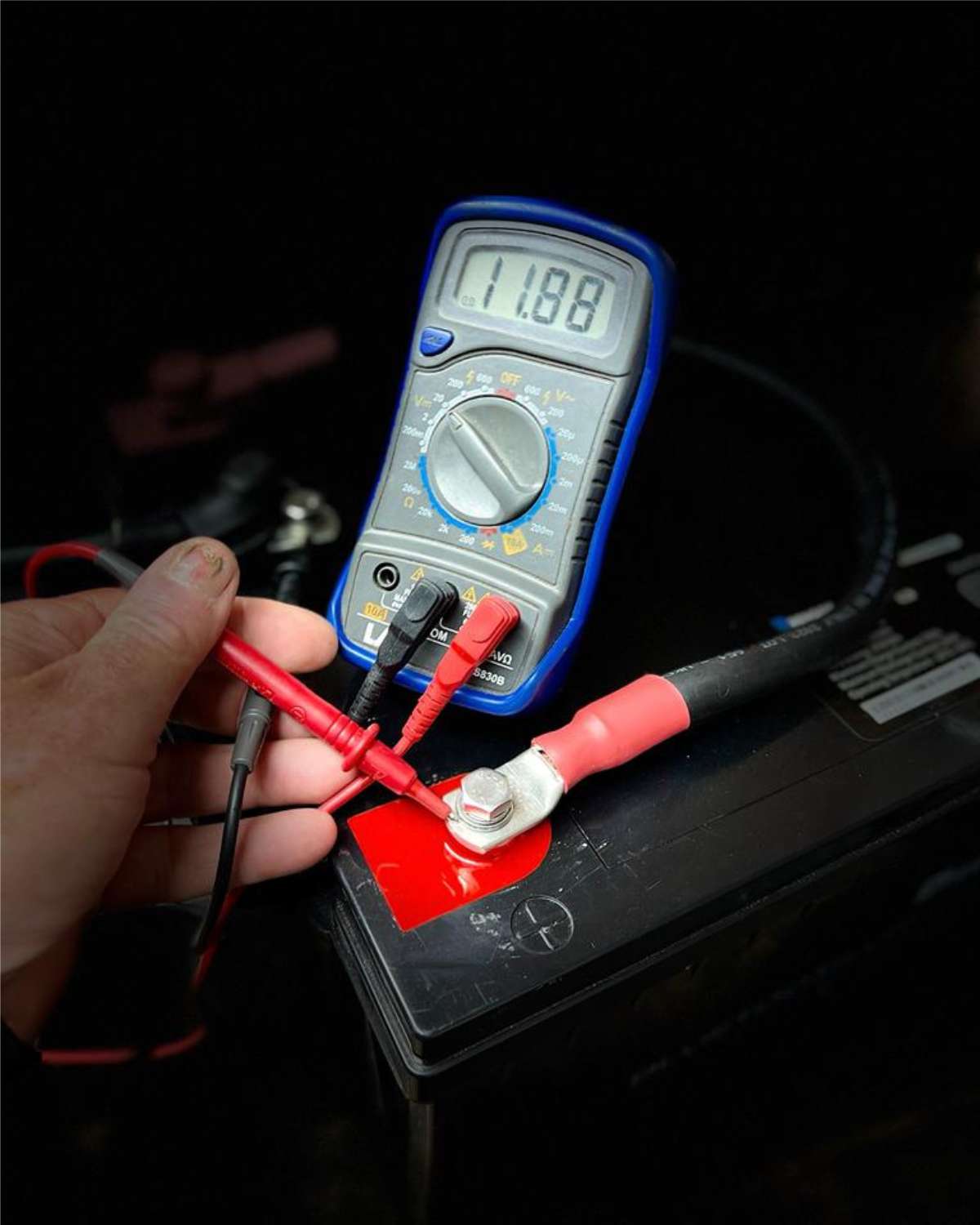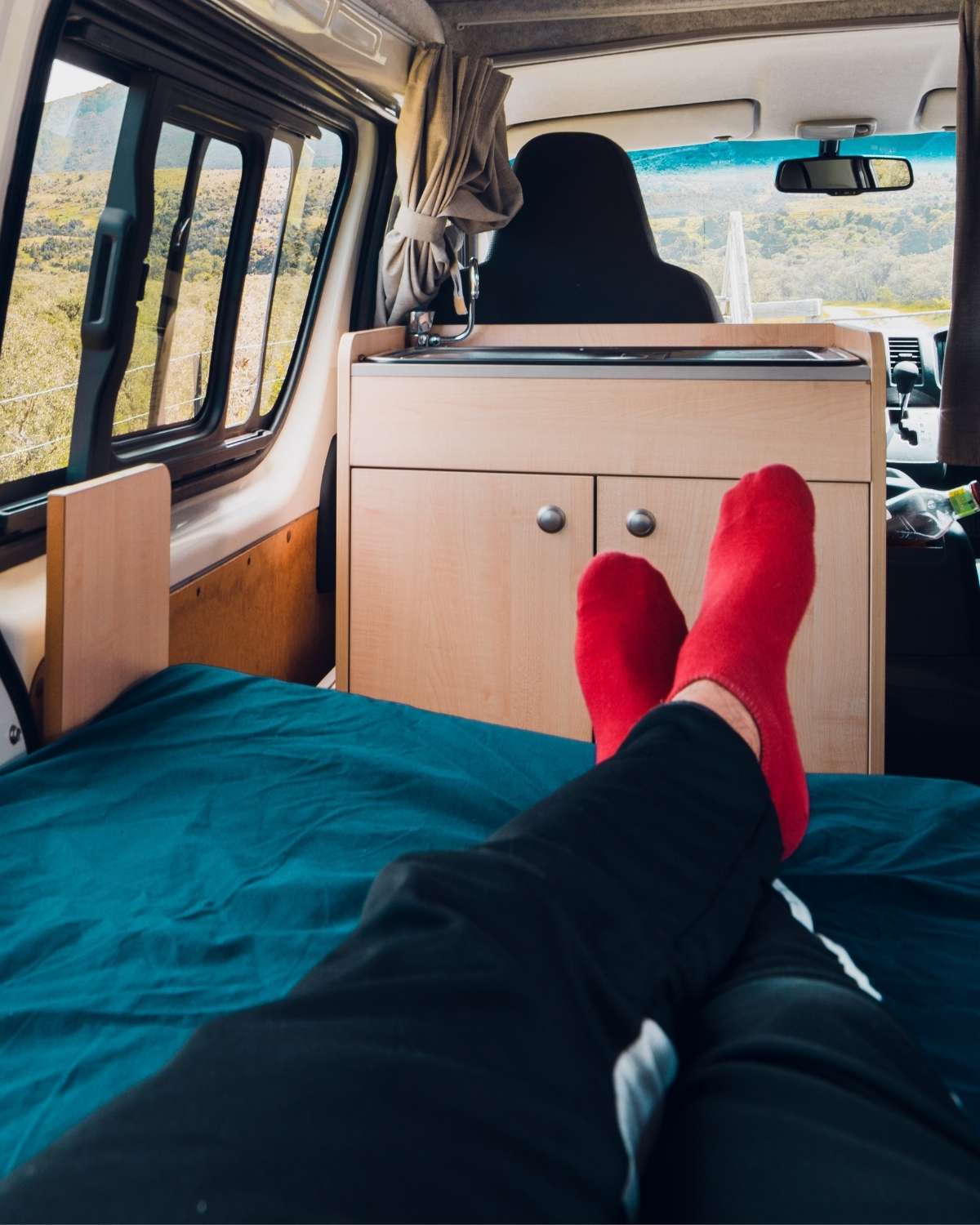Whether you’re living in a camper full-time or using it for gallivanting around on relatively short road trips, things go wrong.
Constantly on the move, the camper’s interior is permanently exposed to vibrations, bumps, and twists.
So things inevitably go wrong from time to time.
However, bringing a well-equipped RV tool kit is a simple way to avoid drama!
In this comprehensive guide, we’ll share some of the essential tools we carry, a guide to what to pack, and a brief tool buyer’s guide.
When you click on links to various merchants on this site and make a purchase, this can result in this site earning a commission. As Amazon Associates, we earn from qualifying purchases. For more info, please check our disclosure page.
We have over 60 tools on this list, so to make navigation easier, we’ve split them into six categories:
- Basic Tools & Equipment Every RV Enthusiast Needs
- Tools for Fixing Camper Electrical Problems
- Must-Have Tools for RV Plumbing Repairs & Leaks
- Essential Kit for Mechanical Repairs
- Safety Equipment
- RV Recovery Kit
Basic Tools & Equipment Every RV Enthusiast Needs
Regardless of your skills, every camper should have a few important tools onboard. They’ll help you in many situations and are in all the best tool kits.
So let’s dive straight in.
1. Toolbox
You need a secure toolbox to put all your RV tools in, so they don’t fly around in an accident.
It also helps you keep organized and store all your tools in one place, so you always know where things are when needed.

2. Complete Tool Kit
The complete tool kit would help you safeguard all the tools in your campervan or RV and make them easy to locate.
A word of warning, though: they’re not always as complete as you might think.
It’s worth checking everything you need, buying a kit that includes it all, or budgeting to buy the pieces not included.

3. Owner’s Manual for Appliances and Kits
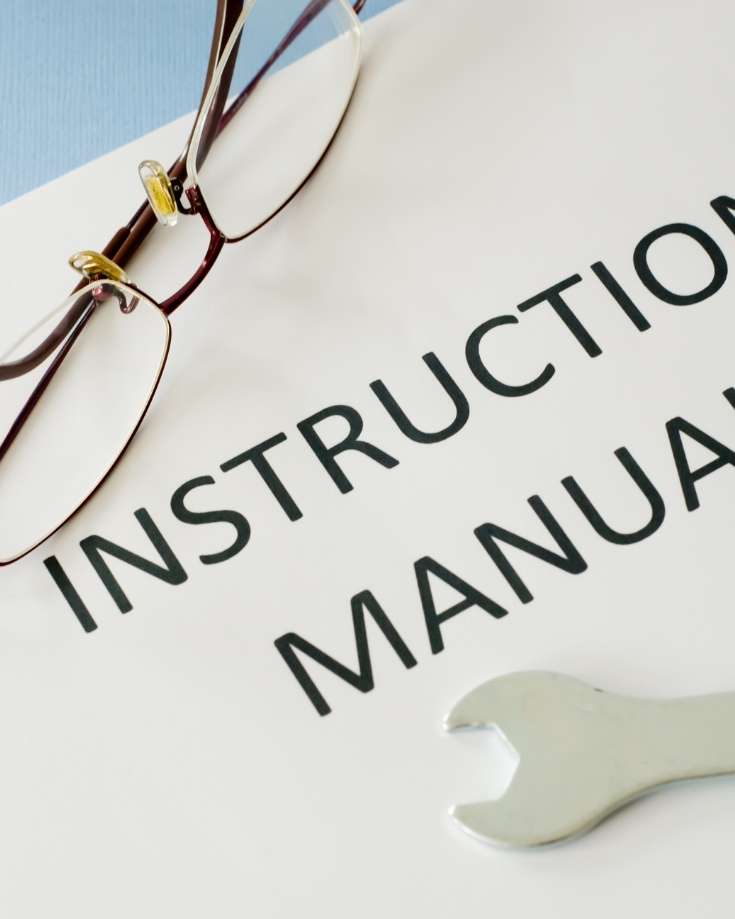
Every appliance you buy for your RV camper should have operational manuals you can consult if you need help using them or troubleshooting.
Plus, they don’t take up much space, so they’re easy to store.
4. Precision Screwdriver Set
Precision screwdrivers have tiny heads for adjusting tiny screws. They help tighten the arm on your glasses, opening the back of small devices like a multimeter, drone, or radio.
We’re surprised by how often we use ours!
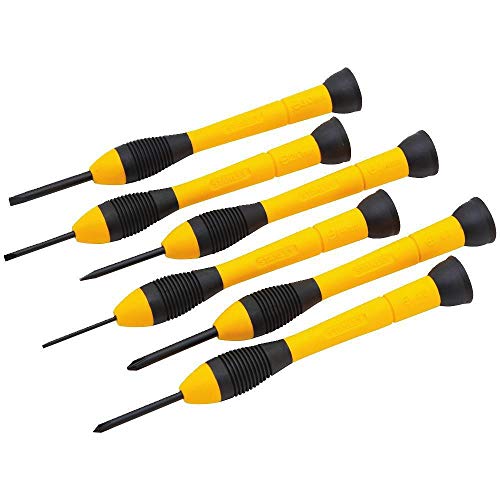
5. Telescopic Ladder
There are a few reasons to climb onto the roof of your camper, including cleaning and maintaining your solar panels.
If you don’t have a ladder attached to the back of the camper, a telescopic ladder is just the thing to help you get on the roof safely.
Because it folds away, well, telescopically, it saves space too.

6. Superglue
Where would we be without superglue? Ideal for emergency repairs:
- temporarily fixing a bit of loose trim,
- filling a chip in the windscreen to prevent further cracking,
- use it on a thread lock for that screw or bolt that is always coming loose with vibrations,
The list of uses is endless. Just don’t stick your fingers together!

7. Tape Measure
A tape measure is always handy around the home (in our case, a van).
You can measure up for replacement parts or just check if your camper will fit under a tree or in a camp spot.
To be fair, a tool box isn’t really a tool box without a tape measure anyway.

8. Pocket Knife
A pocket knife is the most useful item in your pocket. Not just for cutting ropes, but you can use it for peeling fruit and removing splinters.
It makes an ideal whittling tool so great for making fire kindling.
You could even perform an emergency tracheotomy – not that we advise this without the proper medical training!

9. Coveralls
It’s the law of sod. You’ve just showered, got your clean clothes on, and hey presto, you need to crawl around under the van to fix something.
With a pair of coveralls handy, it’s no drama. And it protects you from any falling debris or dripping greywater or oil.
Add a groundsheet to your tool kit, too, so when you’re rolling around under the camper in a wet, muddy field, you’ll keep dry and relatively clean.

10. Shovel
Even if I don’t expect snow, I still keep a shovel in the camper, primarily for digging out if we get stuck.
A trick I learned from our Australian friends in the desert is to use the metal shovel to pick some embers from the fire and place them under your camp chairs to warm your seat on a cold evening.
Be careful not to start a ground fire, though!

11. Headlamp
Another essential tool in an RV camper. I keep mine hanging on the gear shift, so it’s always in easy reach.
Useful when camping at night or looking for something in a dark cupboard or under the camper.
And anyway, what self-respecting camper wouldn’t have a headlamp?
![Vont LED Headlamp [Batteries Included, 2 Pack] IPX5 Waterproof, with Red Light, 7 Modes, Head Lamp, for Running, Camping, Hiking, Fishing, Jogging, Headlight Headlamps for Adults & Kids, Red](https://m.media-amazon.com/images/I/51R7GNIX-xL._SL500_.jpg)
12. Claw Hammer
Always a handy tool to have in your tool kit. Ok, sometimes you need to hammer or bend something out of the way.
The claw end is also helpful for pulling out nails from your tire, removing bonded panels, and a host of other things where you need some leverage.

13. WD40
Should it move? Yes.
Does it move? No. WD40 it!
WD40 is a hygroscopic penetration oil. It was designed to lubricate and keep water and moisture out of steel bolts and fitting. Because of this property, it’s ideal to use on those stubborn, rusted nuts and bolts.
I also use it as a cleaning agent for oily tools and engine bays.

14. Gaffer Tape
Should it move? No.
Does it move? Yes. Gaffer tape it!
A roll of duct tape is much the same as gaffer tape. Bear in mind, duct tape leaves a sticky residue behind when it’s removed.

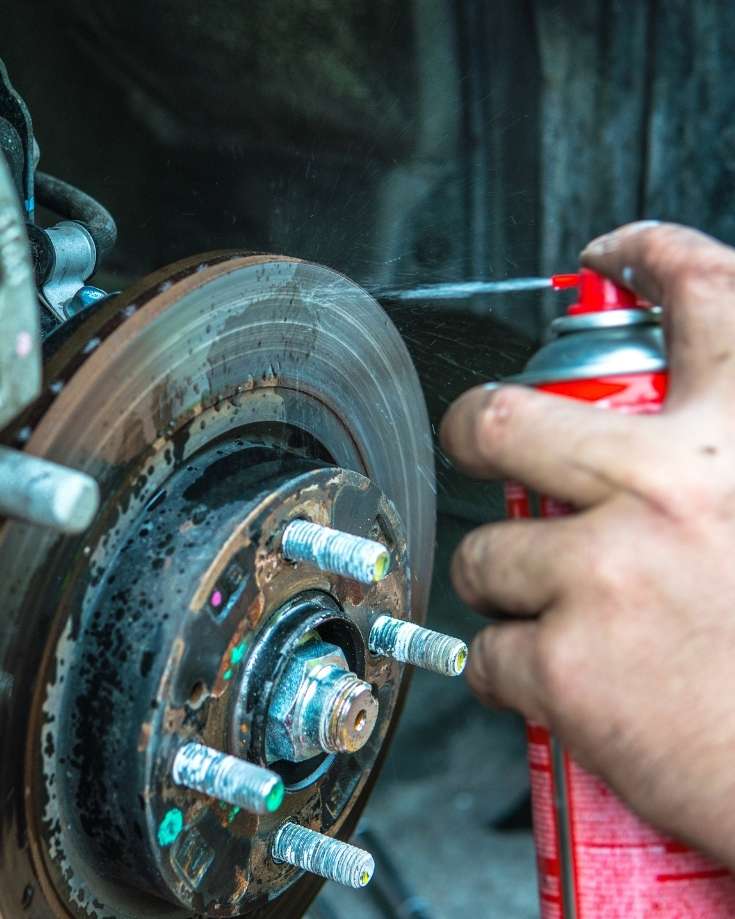
15. Zip Ties
If your camper is a van conversion, you probably used zip ties during your build. They’re great for securing and tidying cables to pipes and posts.
Because they’re so cheap and easy to use, keep a bundle of various sizes in your RV tool kit to help tidy and secure hoses, cables, and covers on all your kit.

16. Allen Wrenches
Modern-day vehicles use many Allen and Torx bolts because they’re quicker to use in construction. That said, they can be difficult to undo without the correct tool.
An ill-fitting Allen wrench will round off the internal hexagon edges making the bolt incredibly difficult to remove.
A mixed set of Allen wrenches is a handy thing to keep in your RV tool box. They come in both metric and imperial sizes, so check which you need before you buy.

17. Cordless Drill
You will use a cordless drill more often than you think.
Yes, they’re ideal for drilling holes and undoing/tightening screws on fixtures and fittings. You could even use it to adjust your leveling jacks.

Tools for Fixing Camper Electrical Problems
Whether you own a DIY campervan conversion or a pre-built recreational vehicle, electrical problems are par for the course.
Include this kit in your camper’s tool kit so you’re prepared to adult find and fix them on the road.
18. Campervan Electrics Handbook
The only book you need to understand how your electrics should work and how to troubleshoot your electrical system.
And it’s brilliant! Now we would say that because we wrote it, but seriously, it’s getting great reviews!
And if you use this link, we’ll give you a complimentary 10% discount at the checkout.
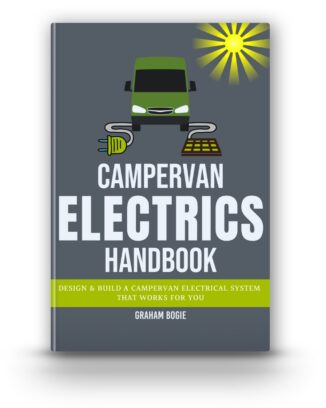
Everything you need to know about campervan electrics. Now available in ebook and paperback!
Learn how to design, size, install and troubleshoot your camper’s electrical system.
19. Crimping Tool & Crimps
Crimping is easier and more reliable than soldering.
Even in the best-installed camper electrical systems, terminal crimps can come loose due to the constant vibrations when driving.
A loose connection will make some systems fail and present an electrical shock hazard. It can cause sparks and, in extreme cases, fire, so it’s essential to have a safe and effective means to maintain them.
Any loose crimps can be replaced and secured with this tool. It’s a good idea to carry a box of assorted wire crimps too.

20. Electrical Screwdriver Set
Electrical screwdrivers are insulated, so you are protected from an electric shock if the business end hits a live wire.
Suppose you’re doing any repairs or maintenance anywhere near your electrical circuits. In that case, it’s better to be safe than sorry and use an electrical screwdriver.

21. Electrical Tape
Use electrical insulation tape to carry out emergency repairs on damaged cabling or crimp terminals. It serves as a temporary repair until you can repair it properly.
I carry black and red tape to mark the positive and negative cables.

22. Spare Fuses
Fuses blow. It’s a fact, and they usually blow at the most inconvenient time.
Always carry a large selection of fuses for your electrical systems. You can get boxes of assorted fuses. Also, include spare ANL fuses for the key components using these specific fuses on your electrical systems.

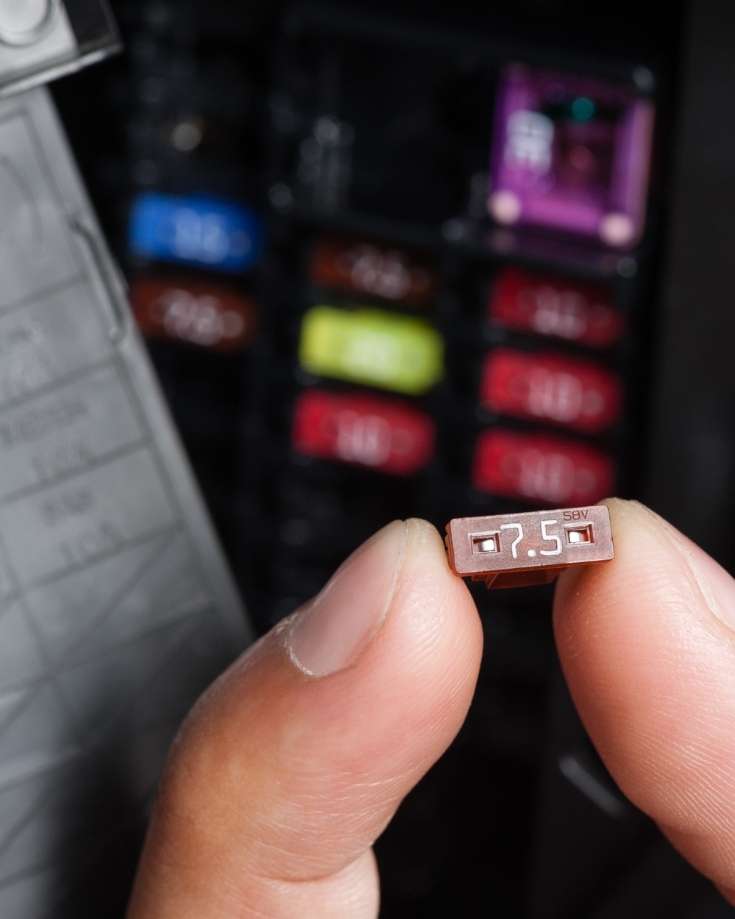
23. Heat Gun & Heat Shrink
A heat gun & heat shrink come in handy with electrical repairs, allowing you to crimp, seal and strengthen an otherwise bare wire.

24. Multimeter
A versatile tool to help fault find and check the health of your RV’s electrical circuits. You can use it to check continuity, resistance, and voltage for both DC and AC circuits.
A multimeter can even read current flow across the entire electrical system. So, it’s worthwhile taking the time to understand how to use it before you venture out and need it.
Luckily, we have a detailed guide on how to use a multimeter in your camper.


25. Solder & Soldering Iron
If you’re repairing, splicing, and joining wires and terminals, you need a solder iron and solder to create a strong join.
The iron is used to heat the solder. It works at a melting point above that of the metal alloy.
Ideally, use a butane-powered iron because it’s more versatile in an RV camper.

26. Wire Strippers
To carry out wire repairs or fit terminals and cables correctly, you need to strip the protective sheathing from the end of the wire.
You could use a sharp knife, but the chances are you will nick the metal stands when you cut or strip the plastic sheath.
Damage to the braided core will introduce weakness or even reduce the cross-sectional area and introduce voltage loss problems.
A good pair of wire cutters often incorporate a stripper. They’re an excellent addition to your electrical RV tool kit.

Must-Have Tools for RV Plumbing Repairs & Leaks
Most campers and RVs have an onboard water system. A leak in a camper is one of the worst things to leave unchecked because it can lead to long-term damage. Below is a list of tools that will be useful in attending to plumbing issues.
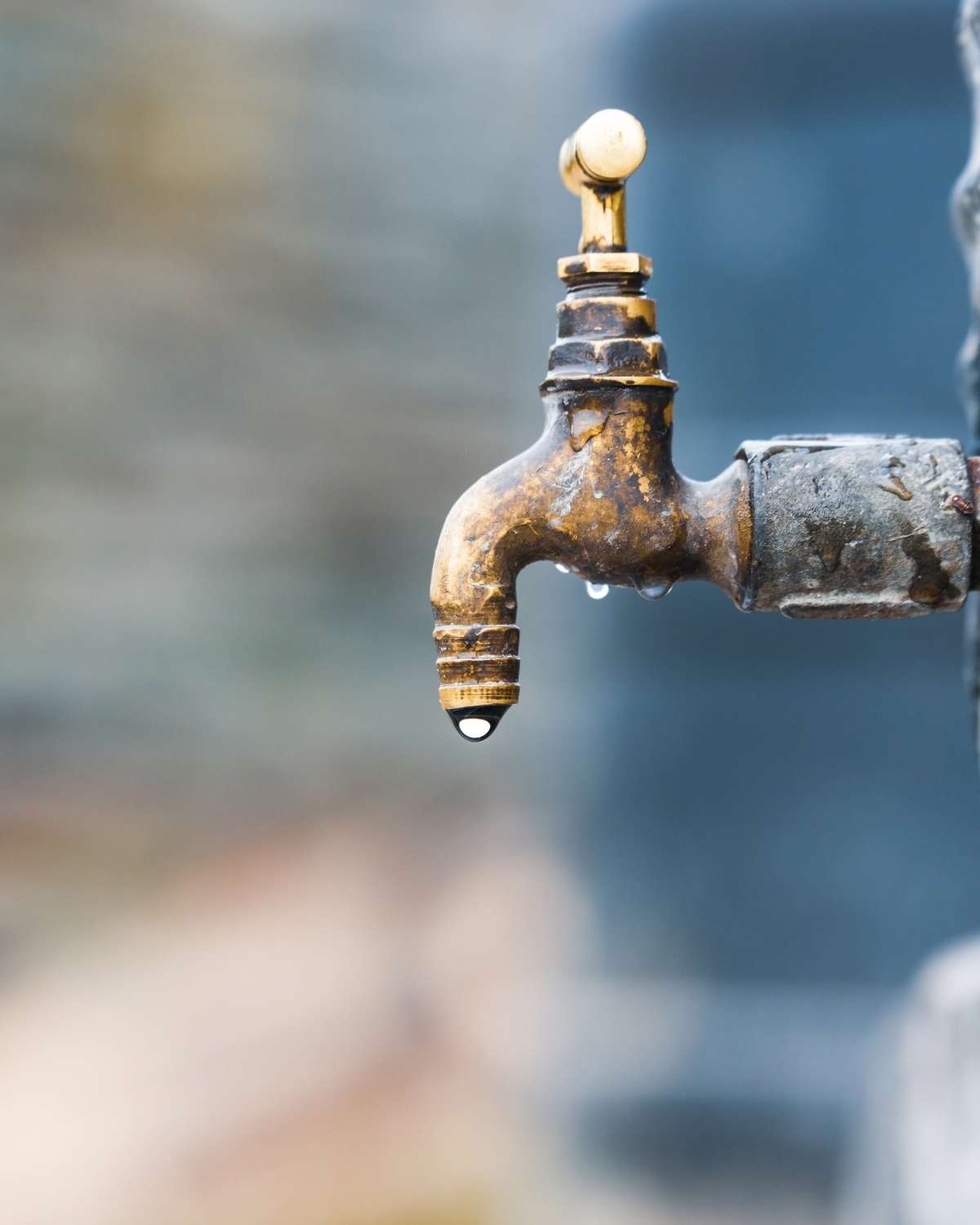
27. Adjustable Wrench
An adjustable wrench is flexible enough to fit most water pipes and connection knuckles. I’m not a great fan of adjustable because when used on a rusted nut, there is a greater chance of rounding off the nut shoulders.
But most water fittings do not need excessive force to tighten the seals. Ideally, you should try and seal water pipe couplings at just over hand tight if possible.

28. Jubilee Clips
This is a hose lock used for joining a hose to a fitting. I carry a box of assorted jubilee clips to use on various pipe sizes.

29. PTFE Tape
Also known as plumbers tape, it seals pipe threads and prevents leakages from joints at strategic places all around the RV.
You must use PFTE tape on all threaded water system joints to prevent water leaks. Check out our guide to RV water tanks for more information on how to use them.
Ideally, keep a couple of rolls in your RV toolbox.

30. Sikaflex
Sikaflex is a versatile adhesive and one of the best sealants for campers and RVs. Use it on seals, windows, roof vent fans, roof leaks, and you could even bond an extra solar panel.

Essential Kit for Mechanical Repairs
A few tools are essential for mechanical issues, maintenance, and repairs of campers, motorhomes, and RVs.
31. Mechanic’s Tool Kit & Socket Set
A general tool kit is an economical way to gather a selection of useful tools, including screwdrivers, pliers, sockets, Allen wrenches, and sometimes Torx sets.
It might not have every specialized tool your vehicle may need, but it is an excellent start to your kit.
Always buy the best brand you can afford, and if you look after it, it will last a lifetime.

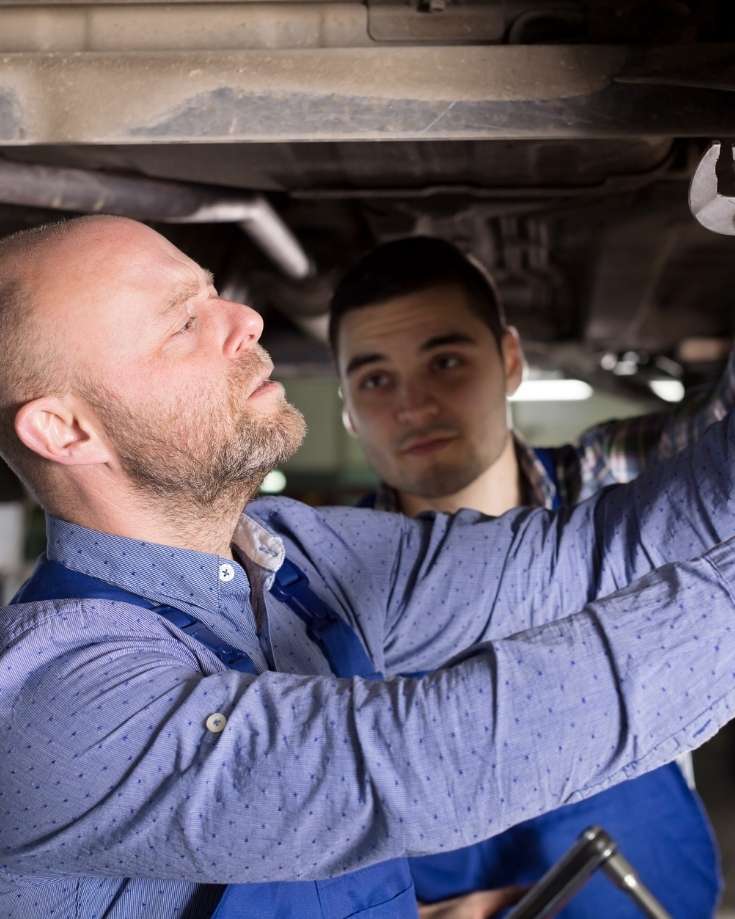
32. Grease
Regular greasing keeps moving parts working smoothly. A tub of general-purpose grease is a handy addition to any RV tool kit.
Use it to keep your sliding doors lubricated and refit wheel nuts to prevent them from seizing over time.
I also use a light smear of grease when fitting rubber seals to hold them in place.
If you need to grease your prop shaft through a grease nipple, you will need to get a grease gun.

33. Oil Filter Tool
It is perfect for taking off oil filters in RVs.
If you plan to get a workshop to change your oil, it is not so important, but even then, I carry one just in case my filter vibrates loose to tighten it.

34. Socket Set
A general-purpose socket set, in the correct sizes and scale (metric or inches), helps tighten nuts and bolts.
A set with a ratchet, extension bar, short and long length sockets, and a flexible knuckle will help in almost any situation.

35. Spanner Set
Having a complete set of spanners handy helps tighten, loosen, and fasten a range of nuts and bolts. I prefer the ratchet combination spanners, but they are expensive.
At least include a combination spanner with an open jaw and a ring, as they are better than the mixed size open spanners.
Again select a spanner set with the correct scale and in a range of your most common nut sizes. Bear in mind you might need two spanners of the same size to undo a nut and bolt where a socket set won’t fit.

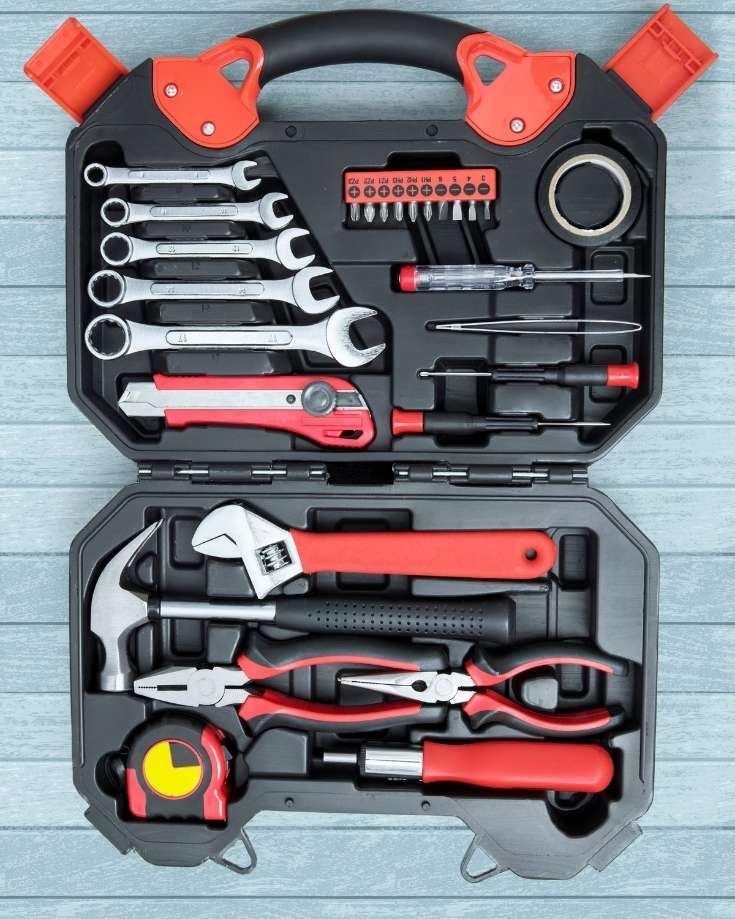
36. Torx Set
Modern-day vehicles are constructed with a lot of Torx bolts. They help with the speed of construction, but they’re not so helpful for our DIY repairs.
You need to use the exact size Torx bit to ensure you get the best grip on the insert to turn the bolt head. It is very easy to strip the bolt insert, making it very difficult to remove the bolt.
When it comes to tightening screws in any part of your RV, a Torx set is ideal because it has a star head that gives it a firmer grip than a regular flathead or cross screw.

Safety Equipment
Here are some tools that can help you keep safe, no matter the situation you find yourself or your camper in.
37. Day-Glo Safety Vest
It’s a legal obligation to carry a Day-Glo safety vest for each passenger and the driver in some countries.
Even if it’s not, it is a sensible thing to carry so that in the event of a breakdown, accident, or bad weather, you’ll be more visible to other road users.

38. First Aid Kit
Again this is a legal requirement to carry one in many countries. It’s essential to keep it well-stocked, too, so doing a stock take every month or so is a good idea.
For more details about what to include, check out our guide to travel first aid kit essentials.
![[New Upgrade] Professional First Aid Kits, First Aid Trauma Kit with Labelled Compartments Molle System for Car, Hiking, Backpacking, Camping, Traveling, and Cycling](https://m.media-amazon.com/images/I/51qx1N0EorL._SL500_.jpg)
39. Window Hammer and Seatbelt Cutter
Whenever I pick a new vehicle, this is the first modification I fit.
A hammer to break the windscreen and a cutter for the seat belts is a sensible safety addition that helps you quickly get out of a damaged or submerged vehicle.
Fit it so either the driver or the passenger can reach it, even if they are upside down in a rolled vehicle. If they can’t both reach, then fit two units, one for each seat.

RV Recovery Kit
When your vehicle gets stuck in a ditch, breaks down, or gets a flat tire, a well-equipped recovery tool kit will come to the rescue.
If you drive a 4wd camper, take a look at our in-depth guide to 4×4 recovery kits. It includes tips and tricks for safely using the gear too.

40. Air Compressor
A portable air compressor is helpful to maintain the correct tire pressure on your camper.
But if you’re anything like us, you’ll enjoy driving the less-trodden path, which usually is soft, or bumpy or corrugated, or all of the above.
Releasing the tire pressure helps to improve traction. The air compressor makes short work of inflating and deflating the tires.
And with the proper adaptor, you can use it to pump up air mattresses, footballs, and even inflatable canoes.

41. Hydraulic Jack
Your RV should already have a jack included as standard, but it’s most likely a scissor screw jack.
They’re not the safest of jacks because they have been known to slip down the thread in an instant.
A hydraulic jack is much safer because they’re more robust, and if they fail, they’ll fail slowly, giving you time to get out of harm’s way.

42. Jack Pad Stand
Most hydraulic jacks have a small base. Because its footprint is small, it can sink into soft ground, or at worst, topple as you lift the vehicle.
It’s a scenario best avoided for both the camper and anyone working on it.
A jack pad extends the jack’s footprint, spreading the vehicle’s weight over a greater surface area, providing greater stability.

43. Tow Rope
A tow strap rated for twice your vehicle’s weight is a sensible addition to your RV tool kit. If you or your buddies get stuck in soft ground, a tow rope, coupled with a D shackle, will help get you unstuck quickly.
D shackles are sized to fit through the manufacturer’s certified recovery points. They should have a working load limit (WLL) rated to at least 1.5x the vehicle’s weight.
Store them dry and in good order, so the threads don’t seize through corrosion. Make sure to connect the D shackle to the manufacturer’s towing points.
Incorrect use of a tow rope is dangerous to bystanders and vehicles. If possible, avoid towing vehicles for long distances with a tow rope.

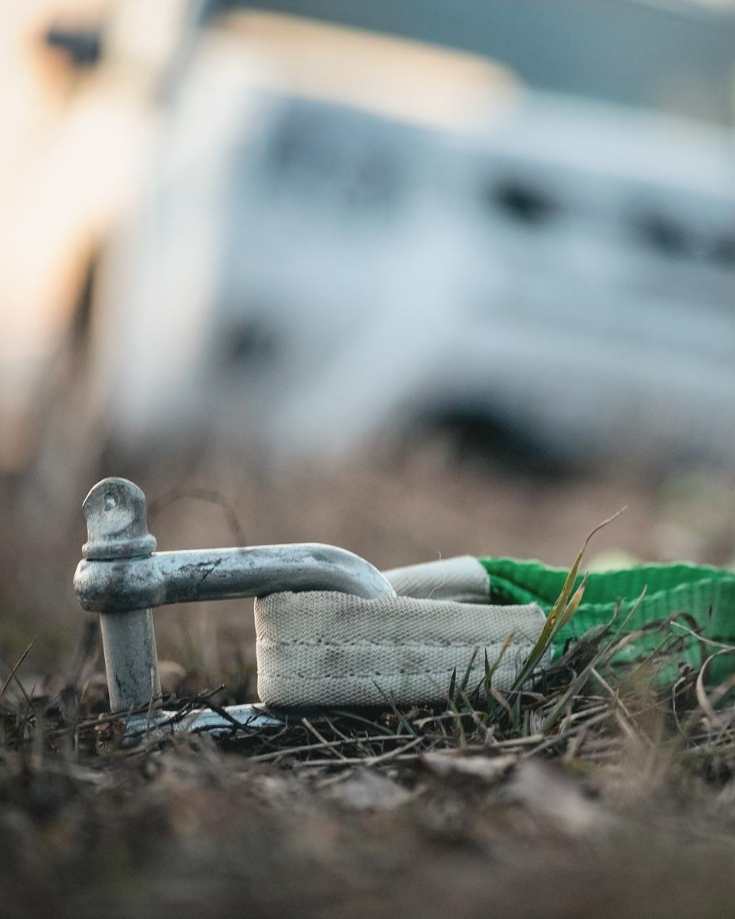
44. Lug Nut Wrench
Wheel nuts are typically tightened to a set torque. Over time, even without any corrosion on the wheel threads, they can become difficult to remove. Not ideal when you need to change a wheel in an emergency.
A lug nut wrench will give you the leverage to make them easier to undo.
Do not use the torque wrench to undo your lug nuts because you could damage this precision instrument with excess force.

45. Tire Fix Spray
Many new vehicles don’t carry a spare wheel, not even a space-saver—the manufacturer’s attempt at cost-cutting, no doubt.
But even with a spare, their tire fix spray is an excellent addition to your tool kit.
We wouldn’t rely on it as our only way to fix a puncture, but it can be convenient to use on a slow puncture and enough to get home or to the nearest tire shop.

46. Tire Pressure Gauge
The gauge helps you measure your tire pressure while getting it filled with air.
Setting the correct tire pressure for highways and byways is good practice. It helps prolong the life of the tires and improves fuel economy.
A digital tire gauge will make the job easy too.
Use the gauge along with your air compressor to set your tire up correctly in all driving conditions.

47. Tire Repair Plugs
This mini tool kit is a fabulous addition to any campervan tool kit. If you get a puncture from a nail or thick thorn, these repair plugs can quickly and easily seal the hole.
Simply use the screw-like tool to insert the rubber strip. With care, you don’t even need to remove the wheel from its hub.
Note: these are temporary repairs. You should get the tire professionally replaced at the first opportunity.

48. Torque Wrench
Loosening, fastening, tightening of nuts are basically what this vehicle recovery tool is used for. When you reattach your wheels, you should retighten the wheel nuts according to the manufacturer’s recommendations.
They stipulate the recommended torque setting, Pounds per feet (lbs-ft), or newtons per meter (Nm).
A breaker bar will help extend the leverage of the torque wrench for more effortless tightening.
Once the wheel nuts are tightened to the correct torque, they should be rechecked using the torque wrench after driving 50 miles.

It is particularly important if you have duals because they tend to loosen due to the two-wheel movements.
What to Consider When Buying Tools for an RV Tool Kit
The most important consideration when buying tools for your RV camper is their quality.
Trying to save money by buying inferior tools is a false economy. And not only that, unless they’re good quality, you don’t want them to fail you when you need them most.
Some tools are pretty expensive so buying used tools is a great way to save some cash and still get a high-quality tool kit.
If you intend to pack power tools, consider the electrical supply. If you boondock a lot, you may not have enough power to run them. Consider cordless tools wherever possible so you can charge the batteries when hooked up to shore power.
How To Decide Which Tools To Pack In Your RV Tool Kit
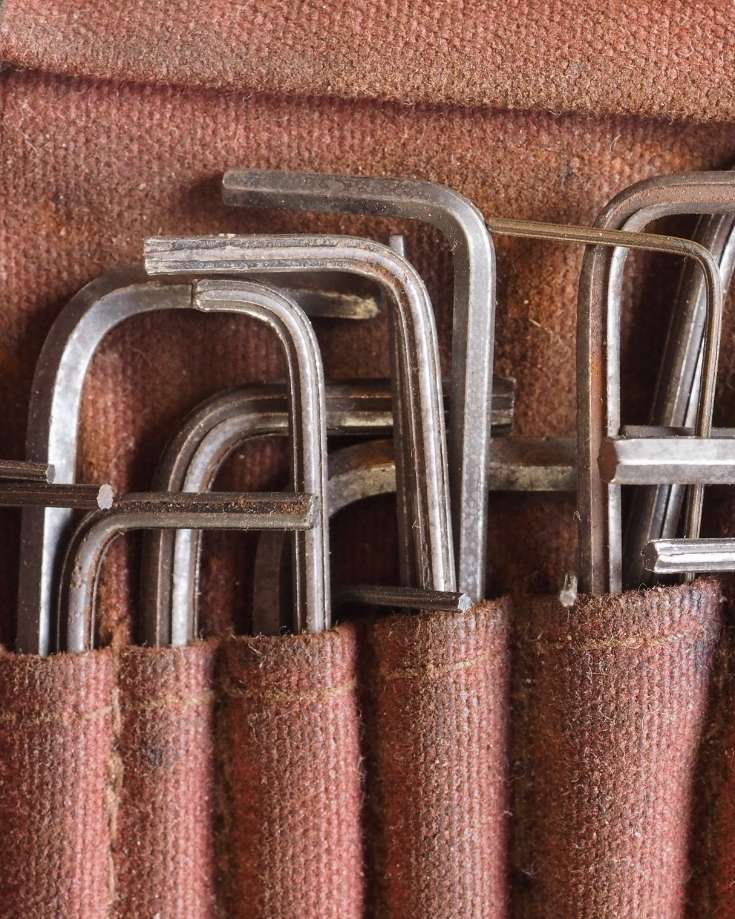
Not everyone will need everything we’ve listed in their RV tool kit. So how do you decide what you should pack and what you shouldn’t?
Asking yourself a few simple questions will help you determine what you need and, just as significantly, what you don’t.
What DIY Skills Do You Have?
Include tools you need to carry out the repairs you’re able to do yourself.
What skills don’t you have? For example, if you’re no mechanic, there’s little chance of you ever using an oil filter wrench.
If you don’t know your way around your camper’s electrical system, you’ll have no use for a multimeter. Well, not unless you buy our book which will teach you everything you need to know!
The only time it’s worth including anything you don’t know how to use is when it’s a specialized tool essential for your vehicle. Then if you can find someone to carry out the repairs for you, you’ll have the right tools they need for the job.
In many remote areas we’ve traveled, we’ve come across garages that don’t have a torque wrench, so that’s always a useful tool to carry. We’ve even been at a tire repair garage where they didn’t even have a jack!
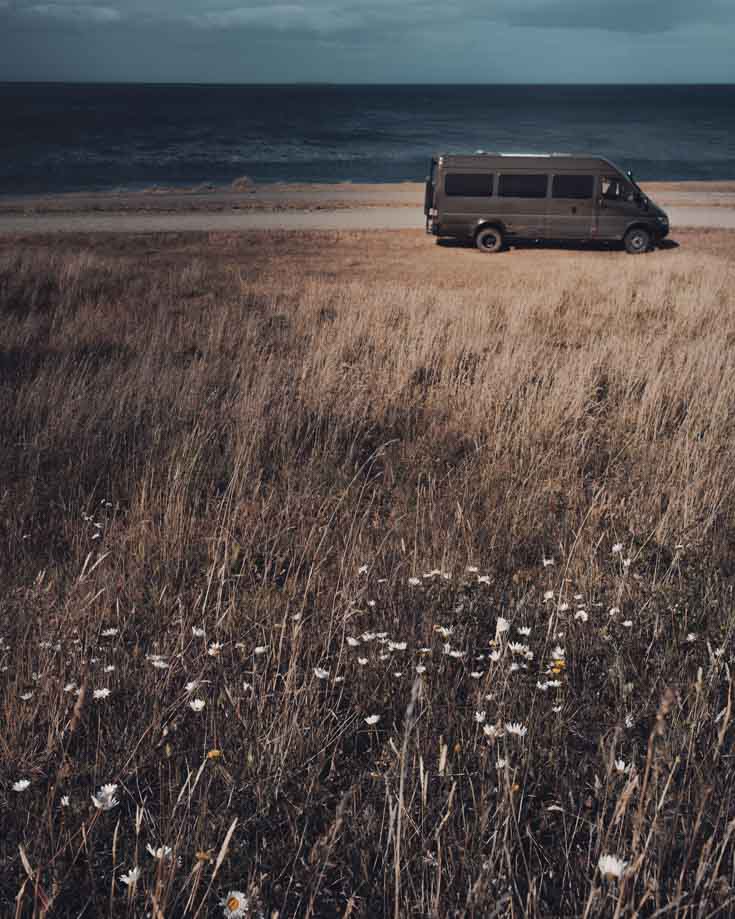
What Tools Did You Use to Build Your Camper?
If your camper is a DIY van conversion, then you’ll have used a lot of tools through the build.
When I converted my Sprinter van from a minibus, I put every tool I used into a toolbox as I used it. Then I knew everything I could ever need to make repairs on the road.
Some of them didn’t make it into my onboard tool kit. I don’t carry the bench saw I used to make the framework of the furniture, for example.
I’m not expecting to have to recut any aluminum tubing for many years to come!
How Much Storage Space Do You Have in Your Camper?
Tools can take up a LOT of space, so there’s little point in overpacking. Find a suitable storage space in your camper for the tool kit and prioritize your packing if you can’t fit everything you need.
How Much Time Will You Spend Off-Grid?
The more time you spend off-grid, the more likely you’ll need to rely on your DIY skills at some point.
The same applies if you’re traveling in remote areas, where appropriate help or language barriers may mean you have to fix things yourself.
Will You Drive Off-Road?
If you’re like us and have a 4wd or even a 2wd and expect to drive off-road, seriously consider packing all the necessary recovery gear.
And learn how to use it because it might save your life.
RV Tool Kit Checklist Pdf
The best RV tool kit is the one you have with you and preferably well-equipped. To help you make sure you have everything you need, use this RV tool kit checklist.
You can download it for free and print it by clicking the link below the image.
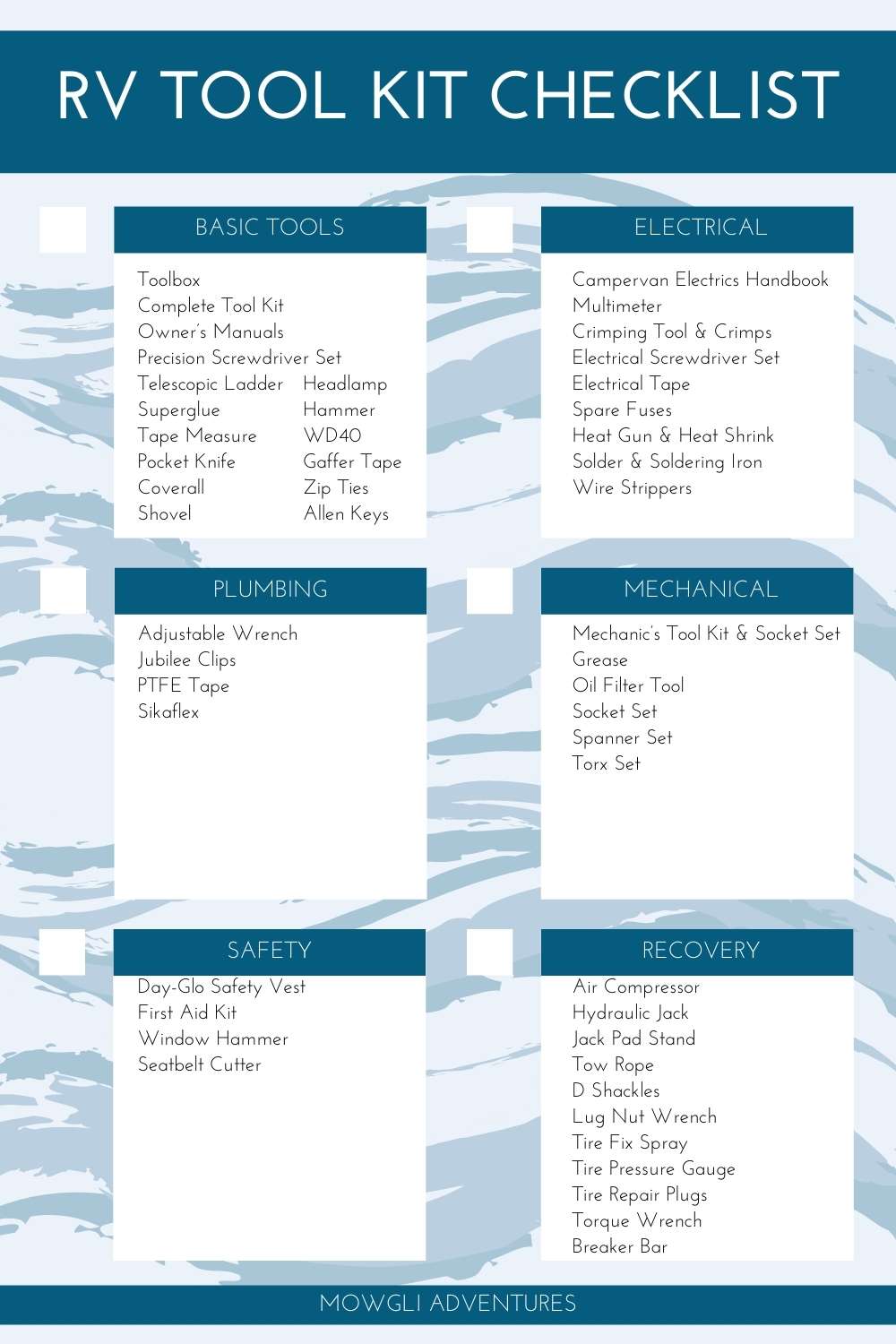
In Conclusion
A well-equipped and thought-out RV tool kit is a must-have in any RV, campervan, or motorhome.
Even for DIY novices, a basic tool kit is an essential piece of gear. It will help you out when you need to make repairs and save you money by spending less on professionals.
Choose your gear wisely, and you’ll be back on the road in no time.
Angela Devaney

Angela Devaney, a former IT project management professional, embarked on an adventurous journey of full-time travel, which included touring West Africa in a converted overland truck and converting an ex-military 4×4 Sprinter van into a camper for a five-year South American expedition. She now utilizes her hands-on experience to create practical RV living and van life advice as a full-time digital media producer, reaching over a million users annually through her YouTube channel, blog, and newsletter. Angela also lends her expertise as the editor-in-chief of the Campervan Electrics Handbook.
